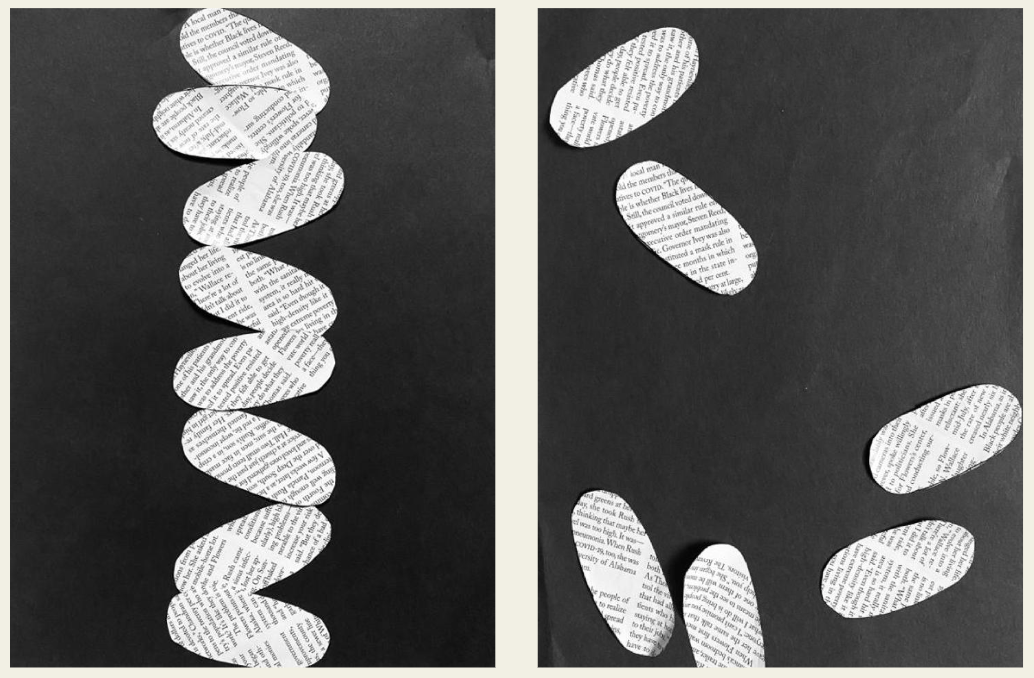Overview
In this lesson, students will explore cutting and arranging shapes to create meaning.
Materials and Tools
- Papers found in the home
- Scissors
- Glue
- Pencil or pen
- Alternative Self-Portrait video
- Alternative Self-Portrait student slides

Objectives
- Students will learn about and implement the elements of art and principles of design
- Students will build problem-solving skills through experimentation with composition
Students will understand that:
- Visual elements of a work of art express ideas
- Color, shape, texture, and line are foundational to design
Students will be able to:
- Use the elements and principles of design to create a visually dynamic and meaningful composition
Activities
Note: The following steps are written with sample language you may use with your students as you go through the lesson. Explain to students that the slides and the video they see during the lesson will be shared with them so they can review the lesson on their own and continue to make more art.
Step 1:Introduction, Paper Collection, with Student Slide #2 (10 minutes)
Today we will be considering how shapes, and the way they are arranged, can create meaning in a work of art. Paper choice, like shape and arrangement, is an important component in creating meaning in a collage.
Look at Slide #2 in the Student Slide deck. These found papers create different meanings. A piece of printed paper tells a different story than a reflective paper.
- What are some other types of everyday papers that come to mind?
- What narrative, mood, or memory do they describe?
Gather various types of papers from around your home – envelopes, magazines, and/or construction paper. As you collect your paper, consider the meaning that each piece holds.
Step 2: Selecting and Cutting a Shape from Found Paper, with Student Slides #3-4 (20 minutes)
Let’s think about how shapes can be used to convey narrative, mood, or memory.
Observe the Jean Arp collage is Student Slide #3.

- What story or meaning do Arp’s shapes convey?
- How would the collage read differently if the artist had chosen to use zigzags rather than squares?
- What do you notice about the edges of the shapes?
- Do you think the meaning of the work would change if the edges were clean
and sharp? Why do you think so?
Select a light and dark piece of paper from your collection and observe Slide #4.

Like the artist in the image, you will be cutting out a single shape from one of your pieces of paper. The artist in the slide chose to cut ovals from her newspaper.
- What do you think the relationship may be between the triangles and the printed page?
- How would the meaning of the work change if she had chosen the
reflective paper?
Select a piece of paper and choose a single shape to cut in different sizes. As suggested in Student Slide #4, cut at least 10 shapes. Be thoughtful about your choice of shape by considering how it relates to your paper.
Step 3: Arranging and Gluing Collage, with Student Slides #5-8 (20 minutes)
So far, we have considered how paper choice and shape convey meaning. Let’s look at how arrangement supports meaning making.
Observe the arrangements in Slide #5.

- How does the arrangement of shapes in the collage that describe the idea of calm differ from the arrangement used to describe an explosive feeling?
Observe your cut shapes. Using the list of words in Slide #6, consider which word best describes your cut shapes. If you can’t identify a word from the list, come up with one on your own. Explore different arrangements that describe your word.

Order, chaos, explosive, calm, joy, sadness, funny
As suggested in Slide #7, document your arrangements. After you have tried and photographed several possibilities, review your images, and select the arrangement you like best to glue to your second piece of paper.
Look at Slide #8 for a quick gluing tip.
Step 4: Reflection Questions for Discussion (10 minutes)
- How did each of your compositions convey different ideas or feelings?
- How does the negative space—the space between the shapes—influence the meaning of the artwork?
Vocabulary
Collage
Arrange
Composition
Negative Space
Document
Resources




